|
Looking back now, it feels like
such a long time ago, but it was only January when I returned from a
wonderful trip overseas. With the intention of avoiding a good part of the
notoriously bleak Caithness winter, I was fortunate enough to organise
time off work. With spectacular scenery, clean/green environment, warm
climate, exhilarating outdoor pursuits and unique wildlife, New Zealand
was always a country I'd dreamed about visiting.
I booked an air ticket, organised a
working visa and with modest funds, took off for land at the other side of
the world where adventure awaited me.
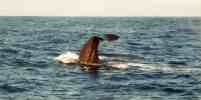
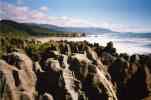
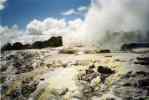
My first impressions of Auckland,
like any major city, was that I could be anywhere in the world and it
didn't promote the unique New Zealand feel I was looking for. Instead I
went from one extreme to another. Leaving a hussly bustly city with bright
lights, designer shops, trendy night-clubs & bars, fine cuisine
restaurants etc., I settled to live and work on a regional park somewhere
on the East coast of the North Island and ultimately in the middle of
nowhere. I was in contact with the parks residential ranger,
Maurice, via e-mail but had only spoken once on the phone before taking
off into the unknown. He sounded friendly and helpful and told me that
accommodation (tin shack, tent, house?) would be provided in exchange for
ranger duties (which were what in NZ - picking rubbish, leading groups??)
and that some food supplies would be required as there were no shops in
the vicinity. I have no idea of what to expect but that was the whole
point and added to the thrill.
It seemed to work out perfectly as
he just happened to be in Auckland on a training course and picked me up
from the backpackers hostel. I was relieved as my backpack was bursting at
the seems and I wasn’t looking forward to struggling with it over long
distances. My back had only just survived lugging it to the hostel.
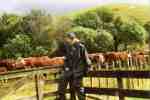 I was picked up in a mini bus with
several other rangers, many of whom were dropped of on route. I learnt Tawharanui Regional Park was the most north of the Auckland Regional
Council sites and I would have the furthest to travel. The journey didn’t
take much more than 1½ hours but it really was in the middle of nowhere.
The nearest town was tiny and a good few miles away along an unsealed road
– good for rally driving especially in a mini bus! I was picked up in a mini bus with
several other rangers, many of whom were dropped of on route. I learnt Tawharanui Regional Park was the most north of the Auckland Regional
Council sites and I would have the furthest to travel. The journey didn’t
take much more than 1½ hours but it really was in the middle of nowhere.
The nearest town was tiny and a good few miles away along an unsealed road
– good for rally driving especially in a mini bus!
I was invited in to Maurice’s house
for dinner and to meet his family. Coronation Street was on in the
background but several weeks out of date. I let a few story lines slip to
Maurice’s wife, Sarah, and spoilt her excitement for the next few weeks!
It was pitch black by the time we
left the house and I could not take in the breath taking views of the
millions of bright stars lighting up the entire sky above me. The 'Plough'
was upside down and it took awhile to figure out some of the more common
figurations. The silence was deafening and slightly eerie - not a sound,
was there any life out there?
In hindsight, it was a silly
question to ask and as the sun rose, so did the rest of the animal kingdom
along with the ranger service. If the office was not attached to the
voluntary accommodation, I would have missed most of the days work.
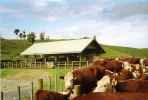 7.30am - bright eyed and bushy
tailed and ready for work. After a 26 hour flight, I still had the excuse
of jet lag so wasn't looking quite as fresh as the other rangers. Soon
woke up when I was instructed about my first week of work. I would be
working with Hereford cattle - tagging and drenching. Did I have his
right, was I on a regional park and not a farm? Cattle, what did I know
about cattle? Well, with fear of a squashed foot or ribs, I was quick to
learn and was in among them at a drop of a hat. 7.30am - bright eyed and bushy
tailed and ready for work. After a 26 hour flight, I still had the excuse
of jet lag so wasn't looking quite as fresh as the other rangers. Soon
woke up when I was instructed about my first week of work. I would be
working with Hereford cattle - tagging and drenching. Did I have his
right, was I on a regional park and not a farm? Cattle, what did I know
about cattle? Well, with fear of a squashed foot or ribs, I was quick to
learn and was in among them at a drop of a hat.
Sorting, tagging, mothering-up,
drenching - I survived the day and declared myself as a natural stock
worker! The next morning I questioned my declaration. Calves were next on
the agenda - cute calves with big brown eyes, I could handle this. These
calves however, had been crossed with a Jersey bull to ease the heifers
first calving. They looked more like deer calves with their long dangly
legs. They fleed across the pens and unlike their docile, slow moving
mothers, managed to plant a few well aimed kicks in my direction. My peely
wally legs were now dotted with dark brown sploges which almost resembled
a mottled tan - I'd have to work on this one.
Apart from the cattle shed, I had
seen little of the regional park. The 'Vole Hole', voluntary
accommodation, was a fully equipped house joined onto the ranger office.
Sleeping 14, it slept 1 for most of the duration of my stay, with only the
occasional student or parties of bird watchers. It was my home for 4
weeks. Its location was ideal, overlooking a sea lagoon and surrounded by
farm and bush land. The birdlife was excellent. My first few nights I was
exhausted after the stock work and so it wasn't until later on in the week
I went exploring around the 588ha park.
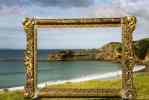 Tawharanui was the biggest of the
Auckland regions parks. Pastureland fell away to rugged reefs, shingled
bays and pure white sand beaches. The beach was my first port of call and
after my first glimpse was visited every day there after. A beautiful
stretch of white sand, crystal clear waters and not one other soul except
myself. The splendour, solitude, peacefulness, sounds of the rolling waves
- it was beautiful. October was still regarded by the Kiwi's as spring and
therefore waters generally too cold for swimming. For a Scot, used to the
chilling waters of home, it was more than pleasant and relaxing to have a
dip after work. The north shore of the main beach was free from litter and
was strictly protected under an offshore marine protection area which
meant nothing was removed. The rare New Zealand doterel could be watched
every day along side the variable oyster catcher and various shag species. On several occasions 'common' dolphins were feeding in the bay. All this
activity, beauty and me! Tawharanui was the biggest of the
Auckland regions parks. Pastureland fell away to rugged reefs, shingled
bays and pure white sand beaches. The beach was my first port of call and
after my first glimpse was visited every day there after. A beautiful
stretch of white sand, crystal clear waters and not one other soul except
myself. The splendour, solitude, peacefulness, sounds of the rolling waves
- it was beautiful. October was still regarded by the Kiwi's as spring and
therefore waters generally too cold for swimming. For a Scot, used to the
chilling waters of home, it was more than pleasant and relaxing to have a
dip after work. The north shore of the main beach was free from litter and
was strictly protected under an offshore marine protection area which
meant nothing was removed. The rare New Zealand doterel could be watched
every day along side the variable oyster catcher and various shag species. On several occasions 'common' dolphins were feeding in the bay. All this
activity, beauty and me!
The sandy coast was only one of the
many habitats on the park. Each habitat possessed its own beauty and
associated wildlife. The farmland and pasture were full of familiar sounds
from bird species such as skylark, yellowhammer and green finch as well as
new sights and sounds from the pukeco and spear plover. The birds, mammals
and plants introduced to New Zealand complete for resources with the
native species. Introductory species brought a share of difficulties
especially with regard to ground nesting birds which were defenceless
against predatory mammals (stoats, weasels, possums). The loss of eggs and
chicks resulted with extinction of some species and danger levels of
others.
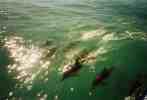 Bats,
seals and cetaceans (whales, dolphins, porpoise) are the only natural
mammals to New Zealand and others are not considered to have a place.
Conservation in New Zealand actually promotes the control of many mammals
which in this country are protected by law. Bats,
seals and cetaceans (whales, dolphins, porpoise) are the only natural
mammals to New Zealand and others are not considered to have a place.
Conservation in New Zealand actually promotes the control of many mammals
which in this country are protected by law.
The regional park was situated on a
peninsula. For this reason it was a suitable site for a ‘mainland island’
project. Many of the wildlife sanctuaries are located on islands for the
reason that predatory species can be eradicated and kept out hence
removing the risk of predation on threatened birds. At present, Tawharanui
is undergoing extensive monitoring of native bird species in order to
measure the success of the 'island' project once the park is fenced off.
Possums not only eat eggs and chicks but affect suitable nesting habitats
and food sources.
I was involved in several
monitoring programmes during my stay. The first was bird monitoring which
involved walking a transect through the bush, stopping at certain points
and conducting 5 minute bird counts. Just my luck that the optimum time
for monitoring was at sunrise. I was struggling to get up at 7am, what
would I be like at 5.45am? Surprisingly I was wide awake and raring to go. We were in place at our first station by 5.45am and the sounds throughout
the bush was amazing. I had learnt a few bird calls but still being my
first week I was pretty clueless. I was fortunate enough to be paired with
an expert in the field and after my first day monitoring, I could
recognise and identify calls of several new species. Tui, grey warbler,
shinny cuckoo, rosella. The bush was so alive with activity and was wild
and untamed. Never have walked through bush country before I was not
exactly prepared and certainly not appropriately dressed for the occasion.
Since arriving at the park, shorts, t-shirt and walking boots was my
attire. The vegetation did not make my walk leisurely. The vines seemed to
jump out from no where and latch around my ankles, the sharp needles of kanuka and manuka trees scrapped my bare legs drawing blood on several
occasions. Under foot, the ground was damp and difficult to grip with the
dead leaf layer giving way to most foot steps. Outwith such monitoring,
the vegetation was seldom disturbed and neither was the extensive webs
weaved by the many spiders. They were practicably invisible and difficult
to avoid so ended up stuck across my face or through my hair. By the end
of the monitoring period, I had literally been dragged through the bush
backwards - covered in cuts, scrapes, mud and sticky web - what a sight!
But it was worth it. I participated in several such monitoring projects
thereafter and survived with fewer mishaps. I learnt to stand at the base
of the vine, swipe a stick through the webs and wear trousers were very
good ideas!
Much of the monitoring on the park
was conducted by volunteers and students. The programmes ranged from radio
tagging hedgehogs to baiting rodent traps and checking pitfall traps. As a
volunteer I spent time with other experienced volunteers who's efforts
were particularly valued on the parks. In some instances, the volunteers
actually organised other volunteers and managed entire projects. I
wondered how this level of involvement could be provided in this country?
Another major project on the park
was the restoration of bushland. Due to the influx of people and family
pressures, a great deal of bushland was destroyed in the past resulting in
a loss of habitat for bird species. Seed was collected locally and grown
in the park nurseries, again much of the work carried out by volunteers.
One of the first things to strike
me was the lack of litter and peoples attitude to dropping litter. Many of
the regional parks were litter free and did not provide bins for
collection. People were simply asked to take their litter home with them
where it could be recycled. This was viewed as the norm and was accepted
as such.
Throughout the 4 weeks I took on a
whole range of tasks and worked with many rangers – they were all very
different but equally fantastic people. From trapping magpies, assisting
at a TV commercial shoot, rounding up sheep, monitoring walking trails to
attending a local fair, eating smoked snapper- it was all new and great
experiences.
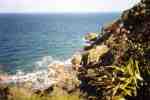 I was sad to leave the regional
park but with limited time, it was time to move on. Over the past 4 weeks
many of the rangers, volunteers and visitors to the parks had mentioned
various other parks and sanctuaries, in particular, Tiri Tiri Matangi, a
bird sanctuary island. It was difficult to get on the island as a
volunteers so I decided to work on another Auckland Council park called
Shakespear. I was sad to leave the regional
park but with limited time, it was time to move on. Over the past 4 weeks
many of the rangers, volunteers and visitors to the parks had mentioned
various other parks and sanctuaries, in particular, Tiri Tiri Matangi, a
bird sanctuary island. It was difficult to get on the island as a
volunteers so I decided to work on another Auckland Council park called
Shakespear.
 The park was situated at the tip of
a peninsula and offered sheltered nays, pastureland, bush remnants and
cliff tops. On arrival I embarked on the heritage trail which took me to a
lookout post which was nothing sort of spectacular. 360 viewing - Auckland
city contrasting with idyllic vistas of the Huraki Gulf and outlying
islands. The park was situated at the tip of
a peninsula and offered sheltered nays, pastureland, bush remnants and
cliff tops. On arrival I embarked on the heritage trail which took me to a
lookout post which was nothing sort of spectacular. 360 viewing - Auckland
city contrasting with idyllic vistas of the Huraki Gulf and outlying
islands.
The volunteer accommodation was of
an excellent standard. A small fully equipped bungalow on the edge of the
park. Located just of a residential area my house was on a bus route - I
could go shopping! Like the Tawharanui rangers the Shakespear rangers were
friendly and helpful and I was never stuck for anything. From food
shopping to bonfire nights - I was always included and made all the
difference for the duration of my stay.
My duties were similar to those at
Tawharanui but the park was smaller with fewer walking tracks and busier
being closer to Auckland. After one week I had walked all the tracks, had
seen al the wildlife and was itching to get over to Tiri Tiri. Quite by
chance I phoned the island for information on a Friday afternoon. After a
friendly telephone conversation I not only managed to organise a visit,
but also voluntary work, accommodation for an entire week!
I left the next day. The 4km
journey from the Whangaparaoa Peninsula took only 20 minutes by ferry. Ray
and Barbara, the resident rangers, were at the pier to meet the boat and
the hundred or so day visitors to the island. The island, owned by
Department of Conservation, is run as an open sanctuary which means the
public are allowed restricted access to insure there is minimum
disturbance to wildlife. A limited number of visitors are allowed each day
and strict rules (such as no dogs, fires, litter) must be followed. The
day visitors were split into groups and led away into the bush with a
'supporter of Tiri Tiri Matangi', voluntary community group guide. I met
up with some researcher students and one other volunteer (Iain who
happened to be Scottish and someone who I chatted to endlessly over the
entire week) and walked to our bunkhouse. A few tasks, which would become
routine over the week, were explained and then the day was ours to explore
the island. The sun was belting down, there was no wind and the island
looked fabulous.
I walked and walked and walked. The numerous tracks and
trails tool me along the rugged coastline and through native bushland. The
scenery was absolutely stunning and in one afternoon I took over 40 shots
of the breath taking views with my camera. Despite 100 other souls on the
island, I came across very few. By 3pm, they had all boarded the ferry and
the island was mine! The birdlife was amazing and many species such as the
saddleback, bellbird, takahe, stickbird fluttered around my head without a
care in the world. Many of these birds were re-introduced to the island
and do particularly well due to unwanted predators been eradicated and the
once pastoral island being replanted with native trees. This restored
habitat provides a safe environment for these rare species such as the takahe and kokako and as a conservation project is considered one of the
most successful in the world.
Over 280,000 trees were planted by
volunteers to create sheltered habitats. Now well established, the
volunteer work has shifted to maintenance of facilities and conservation.
On my first day I completed the
perimeter of the entire island but ran out of time to explore further
before the sun set - it would have to wait for another day. I slept well
that night and looked forward to the next day. Up at 7.30am my first task
was to walk the 'wattle track', a track in the bush and refill the water
troughs. This was the best place to see Tui, saddleback and bellbird, New
Zealand Robin on the island - a wonderful place to wake up each morning.
My duties varied from day to day but were enjoyable tasks such as grass
cutting (on a sit on mower), working in the tree nursery and bird
monitoring. My working day was over around 4pm and off I went to explore
the island further. I often thought this must be one of the places in the
world closest to paradise! Breathtaking coastal scenery, beautiful rare
bird life, clear clean waters lapping along the golden beaches and me.
Each evening I walked for hours, took a dip and headed back to the
bunkhouse to socialise with the researchers over dinner. The bunkhouse
folk were excellent company and a group that got on from the outset.
A couple of nights we tried our to
find the spotted kiwi. Unsuccessful to catch a glimpse, we heard the calls
on occasion. We also managed to rise early one morning for the dawn
chorus. This was deafening - the medidous calls of the bellbirds and tui
in harmony, the sad call of the kokako - unique experience and worth the
effort to get up at 5am.
The week on the island was over in
a flash. On my last evening one of the rangers (another Iain, ancestors
from the Isle of Skye!) took me out on the mirror like bay in a small
rowing boat. As a goodbye treat, he free dived for mussels and clams –
they were woofed down at great speed, very delicious. In the morning I was
not ready to go but leaving in such high spirits and with fond memories,
there was nothing to spoil my illusion that I had actually found an
earthly paradise!
My voluntary work was over. 6 weeks
was a strain on the purse strings and I was forced into finding paid work.
Auckland would be the easiest place to look but how would I cope with the
city lifestyle after the fresh air and wilderness I had become accustomed
to?
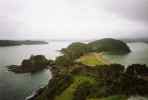 I was unsettled on arrival and
after meeting a few travellers in the bar, decided to escape the city yet
again and join them on a trip up North. We travelled in the ‘Mad Cow’ ,
not a new mode of transport – just a small van painted black and white! We
headed to the Bay of Islands and took a 24 hour cruise which included
everything from fishing, snorkelling, shooting, climbing, island hopping
and kayaking. The biggest sensation was watching the phospho fluoresces in
the water at night under the stars. The sparkling water was like magic
dust and glittered all around the boat where the water was disturbed – an
amazing sight. Again, the trip up North was over in a flash and it was
time to return to Auckland and more importantly find a job! I was unsettled on arrival and
after meeting a few travellers in the bar, decided to escape the city yet
again and join them on a trip up North. We travelled in the ‘Mad Cow’ ,
not a new mode of transport – just a small van painted black and white! We
headed to the Bay of Islands and took a 24 hour cruise which included
everything from fishing, snorkelling, shooting, climbing, island hopping
and kayaking. The biggest sensation was watching the phospho fluoresces in
the water at night under the stars. The sparkling water was like magic
dust and glittered all around the boat where the water was disturbed – an
amazing sight. Again, the trip up North was over in a flash and it was
time to return to Auckland and more importantly find a job!
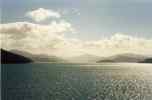 Within a few days I was into the
swing of things and found a casual job in an outdoor store. I worked there
for 3 weeks before embarking on my next adventure. My boyfriend from home
joined me and together we travelled round the north and south islands over
the next 4 weeks. The scenery of the south island reminded me of home but
both islands were equally beautiful in their own way. The places we liked,
we stayed, the places that didn't strike us, we passed through. Within a few days I was into the
swing of things and found a casual job in an outdoor store. I worked there
for 3 weeks before embarking on my next adventure. My boyfriend from home
joined me and together we travelled round the north and south islands over
the next 4 weeks. The scenery of the south island reminded me of home but
both islands were equally beautiful in their own way. The places we liked,
we stayed, the places that didn't strike us, we passed through.
My adventure seemed to go by in a
flash but I made the most of my time and squeezed as much as possible into
the 16 weeks. I found the country to be well geared in wildlife promotion
and catered for wildlife enthusiasts. From sperm whale boating trips from
Kaikoura, Royal Albatross tours near Dunedin, yellow-eyed penguins near
Invercargil & Hectors dolphins in Porpoise bay – I was in my element.
Facilities were excellent and sufficient information to find places and
wildlife with ease. From tramping through pristine National parks,
visiting thermal areas of geysers and boiling mud, skydiving, white water
rafting, viewing glaciers, cruising on remote fiordlands, sun
bathing/swimming/snorkelling along golden beaches - for such a small
country, the variety of the landscapes, recreational activities was
astounding. To see and do the rest………well I’ll just have to go back!
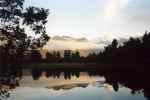
Marina Finlayson
(Marina Finlayson is employed as ranger with the Highland
Council Ranger Service and works in Caithness) |






















